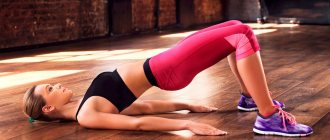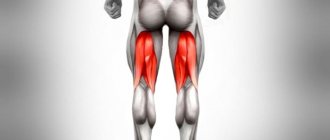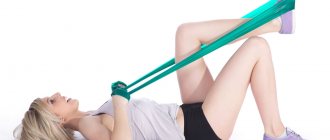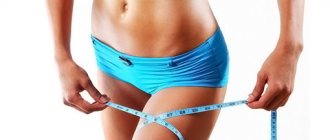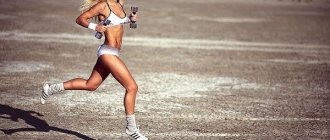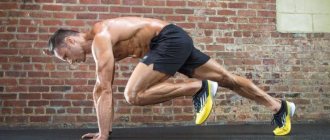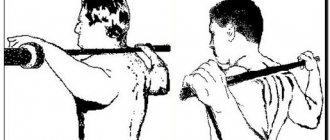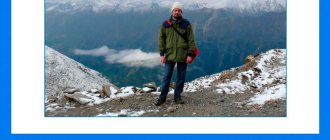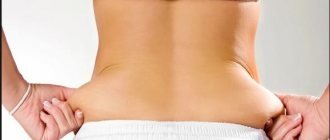Effective exercises for losing weight on the inner thighs
Everyone wants to have a beautiful figure. However, some people are prone to obesity due to a slow metabolism or poor lifestyle. Often, excess fat accumulates on the thighs. Fortunately, there are many effective exercises that can be used to cope with this problem.
Warm-up
The purpose of the warm-up is to improve blood circulation to supply oxygen to the tissues and warm up the joints. Warm-up exercises before leg training:
- rotation of the pelvis;
- rotation of the knees;
- rotation of the ankle.
It is recommended to warm up from top to bottom, so the first thing you should do is perform circular rotations with your pelvis. Then you need to warm up your knee joints, place your legs wider than your shoulders, place your palms on your knees and begin to perform circular movements. After this, you should warm up the ankle.
Exercises at home
In order to achieve the desired result, you need to train regularly. You should do 4-5 workouts per week. Each exercise must be performed in 3-4 sets, 15-20 repetitions. This number of repetitions is considered optimal for burning subcutaneous fat.
Sumo squats
This exercise is performed both with and without weights. You can use dumbbells or other improvised means as additional weight.
How to do it: place your feet slightly wider than your shoulders, and turn your toes to the sides. Keep your back straight, do not slouch, squat slowly until a right angle is formed.
If you find it difficult to maintain your balance, you can go, for example, to a wall and lean on your hands. This exercise should definitely be included in your regular program, as it is the most effective for training the thigh muscles.
Rolling or shifting weight from foot to foot
Beginners are recommended to perform with their own weight, while more advanced athletes should use dumbbells.
Feet wider than shoulder width, hands on your belt (if performing with additional weight, keep them in front of you), squat on one leg, extend the other leg forward as much as possible. At the same time, you need to keep your back straight.
After squatting, you should transfer the weight to the other leg and repeat the exercise. The squat and weight transfer must be performed smoothly. Also, to avoid injuries, you need to ensure that there are no sharp corners in your knees.
Hip adduction while lying on your side
When lying down, you need to lean on your lower arm, while your upper arm should be placed in front of you. The leg that is on top needs to be bent at the knee. Keep your lower leg straight, turn your toes towards you. To perform the exercise, you need to lift your lower leg, you should try to turn your heel up.
After 15 repetitions, you need to change sides, lie on the other side and perform the same exercise with the other leg.
Pelvic lifts
You may need a ball to perform this exercise. But, if the ball is not available, you can practice without it.
To take the starting position, you need to lie on your back, bend your knees, hold the ball between them and place your feet on the floor.
Technique: As you exhale, you should raise your pelvis as high as possible, while simultaneously squeezing the ball with your knees, stay at the top point for 3-5 seconds, and then slowly return to the starting position.
Lifting and abducting legs while lying down
Lie on your back, place your hands behind your head, raise both legs until a right angle is formed with the floor and spread them as wide as possible to the sides
It is important to ensure that your lower back does not lift off the floor.
If you feel that the exercise is easy for you, you can put weights on your legs.
Exercise "scissors"
This exercise, in addition to the fact that it perfectly pumps the inner thigh, also puts stress on the abdominal muscles.
You need to lie on your back, place your hands palms down and rest on your forearms. Then raise your legs above the floor and stretch out your toes. After which, first you need to raise your right leg a little higher and make a sharp movement to the left, with the other leg at the same time you need to perform the same movement to the right. Then repeat, only the left leg should be at the top.
This exercise must be performed for 40-60 seconds, 3-4 approaches per workout.
General recommendations
- A balanced diet will only speed up the approach to the desired result;
- Be sure to do stretching - this will relieve stress on the muscle group being trained and will also relieve painful soreness. Taking a warm bath with sea salt helps a lot;
- Don't neglect massage and wraps. Warming/cooling creams, cling film and a natural bristle brush are your best friends. Massage should be performed from bottom to top along the lymph flow;
- Massage cups are a good helper for skin tightening. To apply it, you need to lubricate the treated area with massage cream or oil and slide the jar from bottom to top until the skin turns red. BUT! This procedure is contraindicated for people prone to varicose veins or who already have spider veins and vascular problems.
- “Bicycle” and “Scissors” are considered especially effective for the butt muscles;
- “Stepping onto the platform” is required to be included in your complex;
- You can build up your muscles with static exercises by completing our “Circular” complex, which includes such an effective exercise as “Chair against the wall.”
- At the end of the workout, do some stretching , such as Downward-Facing Dog and Upward Dog asanas;
- “Walking on the buttocks” not only burns cellulite, but also has many beneficial properties for the pelvic area;
- Well, of course, you can’t do without “Deadlift”.
Exercise 2 straight leg swing while lying down
Lie on your back, place your hands, palms down, under your buttocks and point your toes out.
Swing your straight leg - exhale, lower it to the floor - inhale. Repeat 25 times with each leg.
What to pay attention to: To work the muscles in the front of your thighs, pull your toes as hard as possible and do not relax until you complete the exercise. Do not bend the working leg at the knee, it is better to make the swing a little shorter
And when the muscles get used to the load, feel free to increase the amplitude
Do not bend the working leg at the knee; it is better to make the swing a little shorter. And when the muscles get used to the load, feel free to increase the amplitude.
Do not strain your neck or arch your chest. To avoid helping yourself with your hands, turn your palms up.
Purpose:
This is an exercise for losing weight on the front of the thigh.
Reverse hyperextension
A fun exercise that helps to effectively load the riding breeches area and, as a bonus, the buttocks. Difficulty is average, made harder by a coordination test. To perform this you will need a chair with a soft seat and a bench. Also remember that hyperextension is one of the most effective exercises for the buttocks.
- Starting position – rest your stomach on the seat of the chair, clasp its side with your hands, legs straight, feet together;
- While inhaling, we push our legs up, strongly strain our buttocks, and hang for a second ;
- Exhaling, we return to the starting position.
More details in the video:
The movement should be repeated 15-20 times, with a break, in several approaches. Watch your lower back, avoid excessive bending and tension in it.
Nerve trunks and arteries
The main blood supply of the leg is the femoral artery. It comes out from under the inguinal ligament. Here the anterior group of thigh muscles forms a triangular-shaped depression - the femoral triangle. In this triangle, the femoral artery is not covered by muscles. It is located directly under the fascia. Therefore, in the center of the inguinal fold, you can feel the pulsation of the artery. The largest branch of this great vessel is the deep femoral artery. Their branches deliver blood to the muscles and to the thigh bone. Below the femoral arteries descend to the lower leg.
The femoral region is innervated by branches of two nerve plexuses - the lumbar and sacral. Nerve plexus is an interlacing of nerve roots of the spinal cord. Nerves emerge from the plexuses. Due to this, fibers from different roots are adjacent to one nerve. That is, a nerve impulse, passing along a nerve, will immediately enter several segments of the spinal cord. This mechanism ensures the reliability of the peripheral nerves.
The anterior femoral region is innervated by branches of the femoral and femoral nerves. The outer side is innervated by the lateral (side) cutaneous nerve of the thigh. This small branch often becomes inflamed, causing an excruciating burning sensation - Roth syndrome. Sigmund Freud suffered from this disease. The inner surface is innervated by the obturator nerve.
The posterior surface of the thigh is innervated by the posterior cutaneous nerve of the thigh. The posterior cutaneous nerve of the thigh is a branch of the lumbar plexus. The posterior cutaneous nerve of the thigh also gives off branches that innervate the perineum.
Nerve impulses are transmitted along nerves in two directions.
| Direction | Action | Result |
| From the spinal cord to the muscles. | Impulses sent to the muscles cause them to contract. | We can perform a variety of movements: walking, running, standing on tiptoes, etc. |
| Back: from the skin, muscles, joints - to the spinal cord, and further - to the cerebral cortex. | Rising impulses provide sensitivity. | Thanks to nerve impulses, we feel cold, warmth, pain, touch, and also feel the position of our arms and legs. |
Nervous structure
The nerve endings of the lower extremities descend from the lumbosacral plexus.
Their function is to transmit signals from the central nervous system and back to enable the muscles to move the limb correctly. They also allow the skin to sense touch and temperature changes. If there are disturbances in this area, a person begins to have problems with the muscles of the thigh, flexion and extension of the knees. The main nerve passing through the pelvis along the posterior and outer regions of the femur has a similar name. Its branches provide communication with the central nervous system of almost all organs and tissues of the upper leg. Peripheral nerves branch from the main trunk:
- subcutaneous;
- internal musculocutaneous;
- lateral and anterior cutaneous;
- median muscular.
The obturator nerve, which runs from the lumbar plexus along the lateral wall of the pelvis, also plays an important role. It diverges into two branches - articular and muscular, which connect the corresponding structures near the obturator canal with the central nervous system.
The corresponding part of the genital femoral nerve innervates the oblique and transverse muscles in the inner thigh and the skin near Scarpa's triangle.
The first of them, with the help of lateral branches, innervates the muscular tissues of the dorsal surface of the thigh, participating in flexion of the knee joint. Additionally, it transmits signals to the fibers of the midfemoral region, assisting its adductor actions. The sciatic nerve ends with two large branches - the common peroneal and tibial.
The second, with the help of auxiliary branches, creates the conditions for motor innervation of muscle tissue behind the lower leg. Through its actions, it promotes extension of the ankle joint and flexion of the toes. Responsible for their motor function are two nerve endings located in the sole of the foot.
The common peroneal branch innervates the corresponding muscles, as well as the ventral tissues of the leg, which allows free flexion and lateral movement of the ankle. The influence of this branch is also responsible for the extension of the fingers.
The posterior cutaneous branch participates in the motor innervation of the pelvis, creating conditions for the work of the gluteus maximus muscle. In addition, its activity helps abduct the femoral joint and provides sensitivity to the dorsal femoral surface and the top of the ankle joint.
The essence of the problem
The fact is that the skin in this place is thinner and less elastic, and the inner thighs are the place where fat accumulates the most. Accordingly, these are flabby places that can resemble jellied meat and even shake when walking.
Thin women have the opposite problem. As mentioned above, the inner thigh is where fat is stored. If a person has little fat, then a gap forms between the legs. The thinner the woman, the larger the gap.
The muscles of the inner thighs are adductor muscles. This muscle group includes the gracilis, adductor longus, adductor magnus, adductor brevis, and pectineus muscles. The main function of this muscle group is to change the position of the hip. In other words, with the help of these muscles we bring our legs together and spread them apart.
Main etiological factors
Causes of hip pain:
Injuries to the femur or hip joint after a fall or blow. Professional athletes and people involved in physical activity are susceptible to injury. Fracture of the upper or middle part of the femoral neck. Elderly people are susceptible, they occur in women, due to menopausal disorders. Hormonal changes in mature and elderly women lead to the development of osteoporosis
Fractures appear after careless movement or a fall from one’s own height. Treatment is long and does not always bring the desired effect
In some cases, the formation of a false joint occurs. Fracture of the sacral part of the pelvic bone, pubic bone. Characterized by sharp pain in the groin. An x-ray is taken to differentially diagnose a dislocation in the hip joint. Compression injury in the first lumbar vertebra after falling from a great height and landing on the buttocks. Bruises of the pelvic area.
Sprains and bruises of the soft tissues of the femoral region, internal, biceps, quadriceps muscles. In older people, soft tissue injury results from wear of the ligaments and degenerative changes in the surface of the articular head. In young people, injuries occur after physical activity. Inflammatory diseases in the left hip joint, fibromyalgia, ankylosing spondylitis. The temperature of the joint increases, it turns red and swells. Diseases of the vessels of the thigh and iliac region. If pain occurs in the groin, thrombosis of the femoral or iliac artery may develop. Endocrinopathies, infectious diseases, including osteomyelitis.
Hip pain is caused by physical activity that destroys cartilage and soft tissue. Inflammation in the soft tissues, after injury, irritates the sciatic nerve. This causes pain in the gluteal muscle and back of the thigh. The pain reaches the heel area. The patient cannot stand or sit for a long time.
Nagging pain can be caused by the characteristics of the hip joint, changes in the soft tissues. Pain in the thigh above the middle third or in the groin is caused by pathology in the spine - osteochondrosis, disc arthrosis, narrowing of the spinal canal. Curvature of the spine causes spasm, pain in the muscle of the front surface of the thigh.
If leg pain is left untreated, the frequency and nature of the pain worsens.
Hip and thigh injuries are often treated with surgery. In case of a displaced fracture, the bone fragments are fixed with special knitting needles and titanium plates. In the postoperative period, gymnastics are performed. Perform exercises for the upper body and healthy limb.
Femur fracture
For fractures in older people, surgical treatment in some cases is not performed due to contraindications. The patient is cared for and prevented from bedsores.
Where is hip pain located?
Localization of acute or aching pain in the thigh:
- The front upper part of the thigh hurts due to disorders in the hip joint. Sources of pain are the muscles on the thigh and right hip joint, disorders in the intervertebral discs and joints. Femoral artery and vein, lymph nodes in the groin, pelvic organs in women. The cause of pain in the groin is, in older people, dislocation of the head of the hip joint with displacement of the head forward onto the pubic bone.
- The thigh muscles hurt due to disorders in the lower back and sacral spine.
- The back of the thigh hurts due to problems with the gluteus maximus muscle, its fascia, pathology of the sciatic nerve, and the sacroiliac joint.
- With hernias, fractures, or dislocations of the hip joint, pain appears in the groin.
Groin pain
The pain is aching, nagging, and intensifies at night. It is associated with neurological disorders. Possibly due to oncological pathology of soft tissues or bones. The pain is associated with physical activity, such pain subsides at night, during rest. Common causes of pain are deforming arthrosis of the hip or knee joint. In neurological pathology, impaired sensitivity to temperature changes and skin paresthesia are noted.
With a hernia of the inguinal ligament on the right side, pathology of the vessels of the femoral and iliac region, a nagging pain in the groin develops.
Seven of the best exercises from the ears on the hips
When to exercise: it doesn’t matter - in the morning or in the evening, the main thing is at least an hour after eating. You can incorporate these movements into your strength plan by performing them at the beginning of your workout.
Don't do a set of outer thigh exercises on a cardio day, as most of them put so much stress on your legs that you won't be able to run or even walk as hard as you can.
Equipment: timer (you probably have it on your phone), jump rope, 2 dumbbells of 5-10 kg each (if you need lighter weights, it’s better to do it without weight at all), rubber mat under your feet for jumping, sneakers.
How to do it: perform the exercises one after another. We set the timer so that the first bell sounds after 40 seconds, the second after 20. We do the first exercise for 40 seconds, and then “according to the text.” At the end of the circle, rest for 60 seconds, repeat 4-5 times. Warm up by jumping rope for 5 minutes. In the final we perform the “corner”, “boat”, “cat” from bodyflex. You can also do it with breathing.
Exercise 1. Classic squat
Time: 40 seconds
Why: tightens all leg muscles, burns a lot of extra calories, warms the tensor fascia lata, protects against injuries
We stand with our feet hip-width apart, toes naturally pointed apart. Dumbbells in hands along the body. We squat until our thighs are parallel to the floor, as if we were sitting on a low chair. We stand up while exhaling.
Exercise 2. Plyometric squat
Time: 20 seconds
Why: burns fat
We throw the dumbbells, do the same, only at the point “Thighs are parallel to the floor” we sharply jump up, and then softly land on the front of the foot. We do not straighten our knees completely, and do not strive to assume a “skier pose” (artificially parallel feet).
Exercise 3. Abduction squat
Time: 40 seconds
Why: strengthens all leg muscles, plus trains the tensor fasciae lata in isolation
We perform a squat, dumbbells in our hands, at the lowest point we transfer the weight to the left leg and, standing up, move the right thigh clearly to the right and up. Imagine lifting your leg up the wall, without swinging back and forth. Repeat, alternating legs.
Exercise 4. Kick-side
Time: 20 seconds
Why: burns fat
Do you watch action movies? Yes, that's it - alternate quick kicks to the side. Strike with your heel, not your toe. First, we slightly shift the body to the left, transfer the weight to the left foot, retract the abs, lift off the right leg, move it to the right, bring the heel to the buttock, bending the knee, and from there push-kick the heel to the side. We repeat.
Exercise 5. Lateral leads
Time: 40 seconds
Why: you wanted exercises for the outer thighs?
We lie down on the floor on our right side, place our left hand with a dumbbell along the body, slowly move and bring the thigh up.
Why: burn fat
We get up and go for a short jog, try to do everything gently, don’t knock your feet
Exercise 7. Jumping rope
Why: Maximize calorie expenditure
We jump as comfortably as we can, the main thing is not to fully extend our knees, don’t forget to breathe, and don’t jump on a flat foot.
After completing all seven exercises, take a minute's break and start again from the first. In total you should get 4-5 approaches.
Summary
Surprised? You've probably read on other sites about easier exercises for the outer thigh. Why make it so complicated? The most radical fitness pros only recognize squats with weights of at least 50% of your body weight as exercises for the outer thigh. The problem is that 80% of fitness trainers with training in anatomy and physiology will force the client to do complex movements that burn a lot of calories and work the legs as a whole. And advisors from the Internet will recommend side leg abductions as the best exercise for the outer thigh.
The truth is that fat deposits and flabbiness are a consequence of a lack of tone not only in the quadriceps (this is rare), but also in the muscles of the buttocks, hip extensor and other muscles. So exercises from the ears only work when the entire “bottom” is involved. Well, the notorious hip abductions are a panacea for fat that works if a person is on a super-strict low-calorie diet. In other cases, they burn too few calories. By the way, even really hard workouts do not give you the right to increase your caloric intake significantly. While training with our plan, eat as usual. For those who don’t know, this is an average of 1600-2000 kcal, depending on height, age and weight.
Author of the article Elena Selivanova, fitness trainer
Total comments:
How to improve your thigh shape in a week
You can achieve results in a week if you eat right, do the listed exercises and resort to the following measures.
Massage
Every morning, as well as before training, perform the following sequence of massage movements:
- Rubbing the skin with your palms until you feel a pleasant warmth.
- Intensive massage with hands or a roller massager, preferably using a warming cream;
- Tapping the inner and outer surfaces of the thighs with a regular kitchen rolling pin. Particular diligence should be shown in the most problematic areas - on the so-called “ears”. This can be painful, and the more advanced the cellulite, the more intense the pain. But it's worth being patient.
Brushing gives a very good effect - massaging the skin dry with a brush. Choose a brush according to your feelings: some people need it harder, while others can barely tolerate the softest bristles. This procedure is also very beneficial for the skin - it removes dead skin cells and activates blood circulation.
Wraps
Rapid weight loss in the thighs is also possible with the help of body wraps. The procedure itself is performed according to the following scheme:
- Apply a warming, cosmetic or drainage mask to clean skin (preferably after scrubbing).
- Wrap the body over the working composition with cling film in several layers.
- Wrap yourself in a blanket or robe and relax.
- After 20-60 minutes (depending on the composition), remove the wrap, take a warm shower, and apply nourishing cream.
To reduce the volume of the hips, you can use the following wraps:
- Drainage compositions based on cosmetic clay - white or blue, as well as Dead Sea mud: dilute dry clay with water to the consistency of sour cream, you can add citrus essential oils, known for their anti-cellulite effect.
- Drainage and nutritional mixture based on kelp: dilute dry algae with water, let them swell, if desired, enrich the composition with essential oils and clays.
- Nourishing honey wrap: liquid honey and olive oil in a 2:1 ratio, you can add citrus esters.
- Warming wrap (use with caution and no more than 20 minutes to avoid burns): add a teaspoon of red pepper to the previous recipe.
Sauna
Warming up the body in a sauna increases the effectiveness of any measures aimed at losing weight and improving appearance. It is useful to combine a sauna with massage, masks, rubbing:
- Prepare the following composition for peeling the skin and removing excess fluid from tissues: finely ground salt and honey in a 1:1 ratio, plus the juice of half a lemon.
- Rub clean, damp, preheated skin of problem areas (and best of all the body) right in the steam room.
After the procedure, sweating is activated, and with sweat, toxins accumulated in cellulite fat cells are eliminated.
How to pump up your inner thighs Diet and weight loss magazine
The inner thigh in women is often the most problematic area. Today we will tell you how to pump up your inner thighs here on the website DietMagazine.ru. Regular exercises, namely at least three times a week, will definitely give results, and within a month you will be able to take a fresh look at your reflection in the mirror.
Recommendations for training
Exercises to make your legs thin, as previously mentioned on our website, are best done in well-ventilated areas. For a better mood, you can turn on your favorite rhythmic music, to which your classes will be more fun. First, try to create a convenient schedule of classes, then the results will not keep you waiting.
You need to start with a warm-up to warm up the muscles that you want to pump up, and also to prevent them from stretching during physical activity. As a warm-up, you can walk on the outer ribs of your feet for 3-4 minutes. After this, walk for a few more minutes, raising your knees high.
The muscles of the inner thigh can be pumped up with just one exercise, but if you approach this comprehensively, the result will appear much faster.
Below are the exercises and answers to the question “how to pump up your inner thighs.”
Exercise 1. Raising legs while lying on the floor
These are simple and effective exercises. As you already understand, they need to be performed while lying on your side. We bend one leg at the knee (the one that rests on the floor), support our head with our hand.
Gradually you need to raise your leg and just as slowly lower it, without bending your knee. It is better to repeat the movement up to 20 times for each leg.
To increase the load, increase the number of approaches with each session and you can greatly pump up your inner thighs.
Exercise 2. Side swings
For this exercise you will need a chair or other support. Stand at a distance of approximately half a meter (at arm's length) from the support, grab it with your hand and lean forward slightly. Next, move your leg to the side and back.
The exercise should be done slowly, just like the previous one. You need to do 15-18 repetitions and move on to performing the exercise for the other leg.
By regularly doing these movements, you yourself will be able to advise your friends and acquaintances on the question of “how to pump up the inner thigh.”
Exercise 3. Squats with a load
In gyms, the squat with a barbell has become a very popular exercise for pumping up the inner thigh. Naturally, for this you will need a barbell or an object that will replace it. The exercise is performed from a standing position, legs apart slightly wider than shoulders, feet apart.
You need to take the bar of the barbell, thus placing it on your shoulders. Squat while inhaling, while moving your buttocks back. You should not squat deeply so that your knees do not form an angle less than 90 degrees. Stay in the sitting position for 2-3 seconds and smoothly return to the starting position.
Repeat 12-15 times.
Exercise 4. Stretching
To achieve the desired result, you need to not only pump up your muscles, you also need to stretch them.
How to pump up your inner thighs? Don't forget about stretching exercises!
To pump up your inner thighs, also stretch. Below are several options for stretching exercises:
- Sit on the floor so that your legs form the letter V. Keep your back straight, tense your abdominal muscles, and stretch forward towards your legs. Each time you need to bend deeper and deeper, which will provide better muscle stretching.
- Sitting on the floor, bend your knees, pressing your feet one to the other. You need to spread your knees to the sides, pressing lightly on them, press your legs to the floor. Gradually try to completely press the outer part of your legs to the floor, stay in this position for a few seconds.
- Exercise "frog". Lie on your back with your feet closed and pull them as far as you can closer to your groin. Stay in this position for 10 seconds or more.
- In order to pump up and stretch the inner thighs, lunges known to us from childhood are also suitable. Stand up straight, take your right leg back, and transfer your body weight to your left and bend it at the knee. Gradually lowering yourself down, tense your thighs and buttocks. Stay in this position for a few seconds and repeat the exercise on the other leg.
To accomplish such a “feat” in a short time, how to pump up the inner thighs
and give your legs a well-groomed, beautiful shape, you need to do all the exercises correctly and slowly, you don’t need to make sudden movements. You can do this for yourself, because legs are one of the most attractive parts of a woman’s body!
Jumping Lunges
- We take a vertical position.
- We take one step forward, transferring the entire weight of the body to the exposed leg. The other leg at this time takes a position parallel to the floor surface.
- Keep your back straight and straighten your shoulders.
- Leaning on your leg, we jump up and immediately lower ourselves to the starting position. To make jumping more effective, you can simultaneously swing your arms and clap.
- We repeat the exercise for the other leg.

